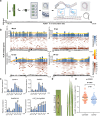Single-Cell and Spatial Transcriptomics Reveals a Stereoscopic Response of Rice Leaf Cells to Magnaporthe oryzae Infection
- PMID: 40123572
- PMCID: PMC12097076
- DOI: 10.1002/advs.202416846
Single-Cell and Spatial Transcriptomics Reveals a Stereoscopic Response of Rice Leaf Cells to Magnaporthe oryzae Infection
Abstract
Infection by the fungal pathogen Magnaporthe oryzae elicits dynamic responses in rice. Utilizing an integrated approach of single-cell and spatial transcriptomics, a 3D response is uncovered within rice leaf cells to M. oryzae infection. A comprehensive rice leaf atlas is constructed from 236 708 single-cell transcriptomes, revealing heightened expression of immune receptors, namely Pattern Recognition Receptors (PRRs) and Nucleotide-binding site and leucine-rich repeat (NLRs) proteins, within vascular tissues. Diterpene phytoalexins biosynthesis genes are dramatically upregulated in procambium cells, leading to an accumulation of these phytoalexins within vascular bundles. Consistent with these findings, microscopic observations confirmed that M. oryzae is prone to target leaf veins for invasion, yet is unable to colonize further within vascular tissues. Following fungal infection, basal defenses are extensively activated in rice cells, as inferred from trajectory analyses. The spatial transcriptomics reveals that rice leaf tissues toward leaf tips display stronger immunity. Characterization of the polarity gene OsHKT9 suggests that potassium transport plays a critical role in resisting M. oryzae infection by expression along the longitudinal axis, where the immunity is stronger toward leaf tip. This work uncovers that there is a cell-specific and multi-dimensional (local and longitudinal) immune response to a fungal pathogen infection.
Keywords: Magnaporthe oryzae‐rice interaction; single‐cell transcriptomics; spatial transcriptomics; vascular immunity; longitudinal immunity.
© 2025 The Author(s). Advanced Science published by Wiley‐VCH GmbH.
Conflict of interest statement
The authors declare no conflict of interest.
Figures






References
-
- Li L., Yu Y., Zhou Z., Zhou J. M., Sci. China Life Sci. 2016, 59, 878. - PubMed
MeSH terms
Supplementary concepts
Grants and funding
LinkOut - more resources
Full Text Sources
